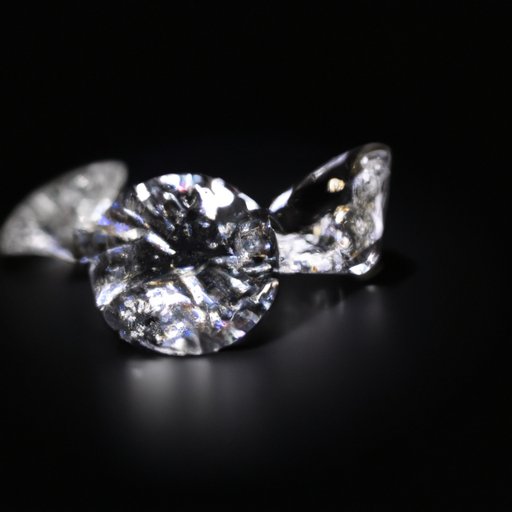
Introduction
The idea of purchasing a fake diamond can be daunting, especially when it comes at a high price. However, distinguishing between a real diamond and a diamond simulant can be challenging for a buyer with a limited knowledge in gemstones. The good news is, there are specific techniques you can use to determine if a diamond is real or fake. In this article, we will look at different approaches including testing methods, the importance of the 4 C’s, and common scams to avoid.
Explaining Diamond Composition
Diamonds are a crystalline form of carbon created under high pressure beneath the earth’s surface. The main difference between a diamond and diamond simulant is their chemical composition. Diamond simulants may look identical to naturally formed diamonds but don’t possess their chemical properties. Cubic zirconia, moissanite, and glass are some examples of diamond simulants you may come across.
How can you distinguish between real diamonds and diamond simulants? Real diamonds have unique and distinct properties that differentiate them from diamond simulants. While diamond simulants reflect colors in a rainbow pattern, a real diamond reflects light in a grey shade. Real diamonds have more brilliance and spark than diamond simulants, which look flat and lifeless.
Importance of the 4 C’s
The 4 C’s are the four characteristics that jewelers use to grade diamonds. They are; clarity, cut, color, and carat weight. The size of a diamond doesn’t necessarily gauge its value. Factors such as its cut, color, and clarity can significantly impact its value.
Real diamonds stand out because of their quality, and you can use the 4 C’s to identify if a diamond is genuine or fake. A real diamond will score high on each of the 4 C’s metrics. Jewelers use loupes or microscopes to identify any inclusions (imperfections) in a diamond and determine its clarity. Real diamonds have unique and specific inclusions depending on how they were formed, which distinguishes them from diamond simulants. Diamond simulants, on the other hand, may have different shapes, bubbles, or scratches visible under a loupe or microscope.
Step-by-Step Home Testing
You can use some easy tests to determine if a diamond is genuine or fake. One DIY method is the fog test, where you breathe on the diamond and observe whether it fogs up. A fake diamond will fog up because it won’t retain heat, unlike a real diamond, which disperses heat instantly. Another is the water test, where you place the diamond in a glass of water. A real diamond will sparkle, whereas diamond simulants will remain murky.
Another effective method is using a UV light source. UV radiation will cause a diamond to produce a blue glow that lasts for two to four seconds. Diamond simulants don’t have this property, making them easy to identify.
Common Diamond Scams and How to Avoid Them
Diamond scams are prevalent and can cost you money. Fake certificates, underweight rings, and misleading advertisements are among some scams to watch out for.
To avoid these scams, it’s essential to buy jewelry from reputable vendors who offer certifications and warranties. Ensure you go through reviews and research a vendor’s certification and accreditation before placing your order.
Third-Party Certification Agencies
Several diamond certification organizations exist, including the Gemological Institute of America (GIA), the American Diamond Society (ADS), and the European Gemological Laboratory (EGL). These organizations provide independent and unbiased grading certificates that indicate the 4 C’s score for a diamond. You can use these certificates to verify a diamond’s authenticity and quality.
Tips for Spotting Real Diamonds in Used Jewelry
It can be tricky to determine the authenticity of vintage or used diamond jewelry because it may have gone through several owners. When buying used diamond jewelry, ensure you do research and shop for pieces from established and trustworthy sources. Specific cuts and grades may indicate the authenticity of the diamond.
If you’re struggling to identify whether a diamond is authentic or fake, the best course of action is to consult an expert. Professional and reputable jewelers and gemologists can examine your diamond and provide an accurate evaluation.
Conclusion
In conclusion, buying real diamonds isn’t as complicated as it may seem. With basic knowledge of the 4 C’s, and the different properties between diamond simulants and authentic diamonds, you can quickly identify and authenticate a diamond. By using certified vendors or third-party certification services, you can be sure to receive the genuine article. Don’t let diamond scams and fake diamonds discourage or intimidate you. Research and use the tips discussed in this article to ensure you purchase genuine quality diamonds that will last a lifetime.
Do you have any tips or experiences in identifying real diamonds that you’d like to share? Leave a comment below.




